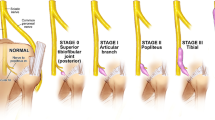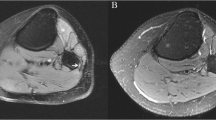Abstract
Background
Tibial intraneural ganglia occurring in the popliteal fossa are often misdiagnosed because of their relative rarity. Their joint connection is typically not recognized and therefore not treated, leading to recurrence.
Study design
This is a retrospective clinical study.
Materials and methods
Magnetic resonance images (MRIs) of six patients with confirmed tibial intraneural ganglia arising from the superior tibiofibular joint were analyzed and were compared to ten individuals with normal tibial nerves who were imaged with MRI. All studies were interpreted as left-sided. A previously designed clock face model introduced for peroneal intraneural ganglia was used to describe the superior tibiofibular joint connection (tail sign). A single axial image was sought to determine the normal anatomic and pathologic relationships of the tibial nerve and tibial articular branch to the superior tibiofibular joint.
Results
In all patients with intraneural ganglia, a single conventional axial image at the mid-fibular head level could reliably demonstrate: (1) intraneural cyst within the articular branch at the superior tibiofibular joint connection (tail sign) between 8 and 9 o’clock and intraneural cyst within the tibial nerve, (2) the central location of the tibial nerve posterior to the tibia, and (3) popliteus muscle denervation changes and atrophy (popliteus sign).
Conclusions
This technique can provide radiologists and surgeons with rapid and reproducible information for diagnosis and treatment planning of tibial intraneural ganglia. Similar to its use with the clock face model in peroneal intraneural ganglia, a standard axial image at the mid-fibular head level can be used to interpret key features of tibial intraneural ganglia and identify the joint connection. Improved identification of the presence of a joint connection will change the therapeutic approach of this pathology and reduce cyst recurrences.





Similar content being viewed by others
References
Friedlander HL. Intraneural ganglion of the tibial nerve. J Bone Joint Surg Am 1967;49: 519–522.
Mahaley MSJ. Ganglion of the posterior tibial nerve. Case report. J Neurosurg 1974;40: 120–124.
Malghem J, Vande berg BC, Lebon C, et al. Ganglion cysts of the knee: articular communication revealed by delayed arthrography and CT after arthrography. AJR 1998;170: 1579–1583.
Spinner RJ, Atkinson JL, Harper CM Jr, et al. Recurrent intraneural ganglion cyst of the tibial nerve. Case report. J Neurosurg 2000;92: 334–337.
Malghem J, Vande BB, Lecouvet F, et al. Atypical ganglion cysts. JBR-BTR 2002;85: 34–42.
Krishnan KG, Schackert G. Intraneural ganglion cysts: a case of sciatic nerve involvement. Br J Plast Surg 2003;56: 183–186.
Rezzouk J, Durandeau A. Nerve compression by mucoid pseudocysts: arguments favoring an articular cause in 23 patients. Rev Chir Orthop Reparatrice Appar Mot 2004;90: 143–146.
Tseng KF, Hsu HC, Wang FC, et al. Nerve sheath ganglion of the tibial nerve presenting as a Baker's cyst: a case report. Knee Surg Sports Traumatol Arthrosc 2006;14: 880–884.
Gosk J, Rutowski R, Urban M, et al. Intraneural ganglion of the tibial nerve—a case report. Neurol Neurochir Pol 2007;41: 176–180.
Spinner RJ, Mokhtarzadeh A, Schiefer TK, et al. The clinico-anatomic explanation for tibial intraneural ganglion cysts arising from the superior tibiofibular joint. Skeletal Radiology 2007;36:281–292.
Spinner RJ, Atkinson JLD, Tiel RL. Peroneal intraneural ganglia: the importance of the articular branch. A unifying theory. J Neurosurg 2003;99: 330–343.
Groulier P, Benaim JL, Curvale G, et al. Compression of the posterior tibial nerve by a synovial cyst arising from the superior tibio-fibular joint. Report of a case. Rev Chir Orthop Reparatrice Appar Mot 1987;73: 67–69.
Sansone V, Sosio C, da Gama Malchèr M, et al. Two cases of tibial nerve compression caused by uncommon popliteal cysts. Arthroscopy 2002;18: E8.
Spinner RJ, Amrami KK, Wolanskyj AP, et al. Dynamic phases of peroneal and tibial intraneural ganglia formation: a new dimension added to the unifying articular theory. J Neurosurg 2007;107: 296–307.
Spinner RJ, Atkinson JL, Scheithauer BW, et al. Peroneal intraneural ganglia: the importance of the articular branch. Clinical series. J Neurosurg 2003;99:319–329.
Spinner RJ, Luthra G, Desy NM, et al. The clock face guide to peroneal intraneural ganglia: critical “times” and sites for accurate diagnosis. Skelet Radiol 2008;37: 1091–1099.
Acknowledgments
The authors appreciate the assistance of Phillip Edwards, Jon Camp, and David R. Holmes in the Biomedical Imaging Resource (Mayo Clinic).
Author information
Authors and Affiliations
Corresponding author
Rights and permissions
About this article
Cite this article
Spinner, R.J., Hébert-Blouin, MN., Maniker, A.H. et al. Clock face model applied to tibial intraneural ganglia in the popliteal fossa. Skeletal Radiol 38, 691–696 (2009). https://doi.org/10.1007/s00256-009-0651-8
Received:
Revised:
Accepted:
Published:
Issue Date:
DOI: https://doi.org/10.1007/s00256-009-0651-8




